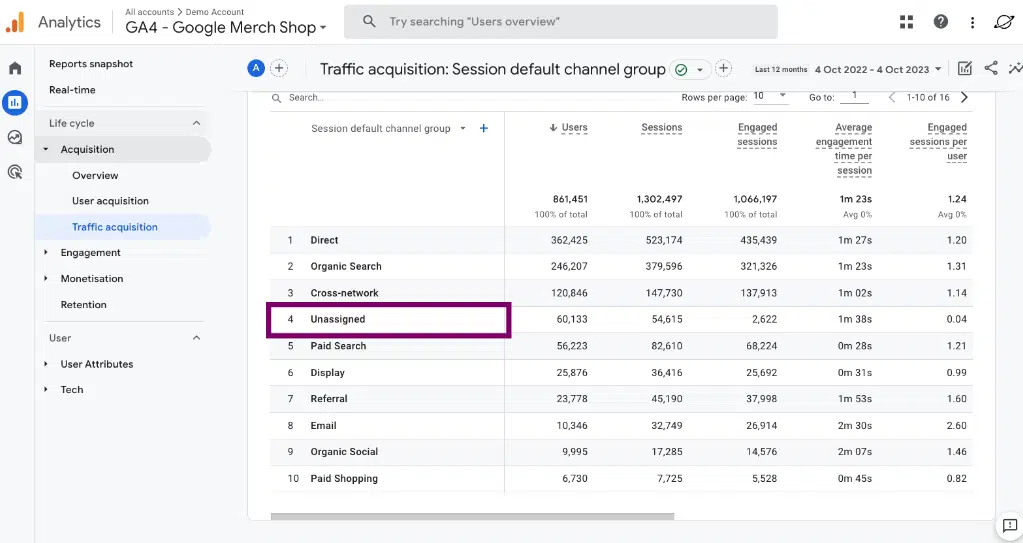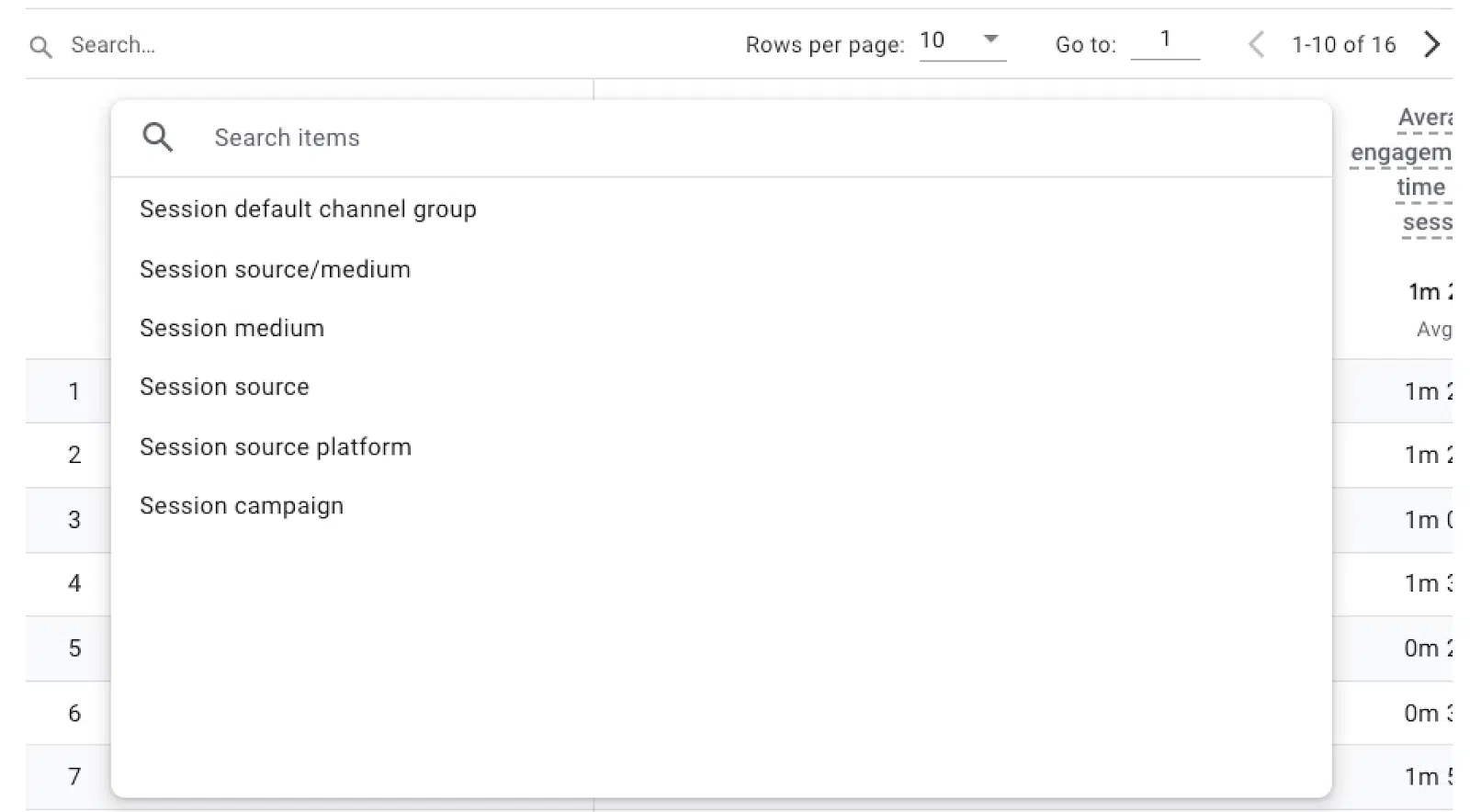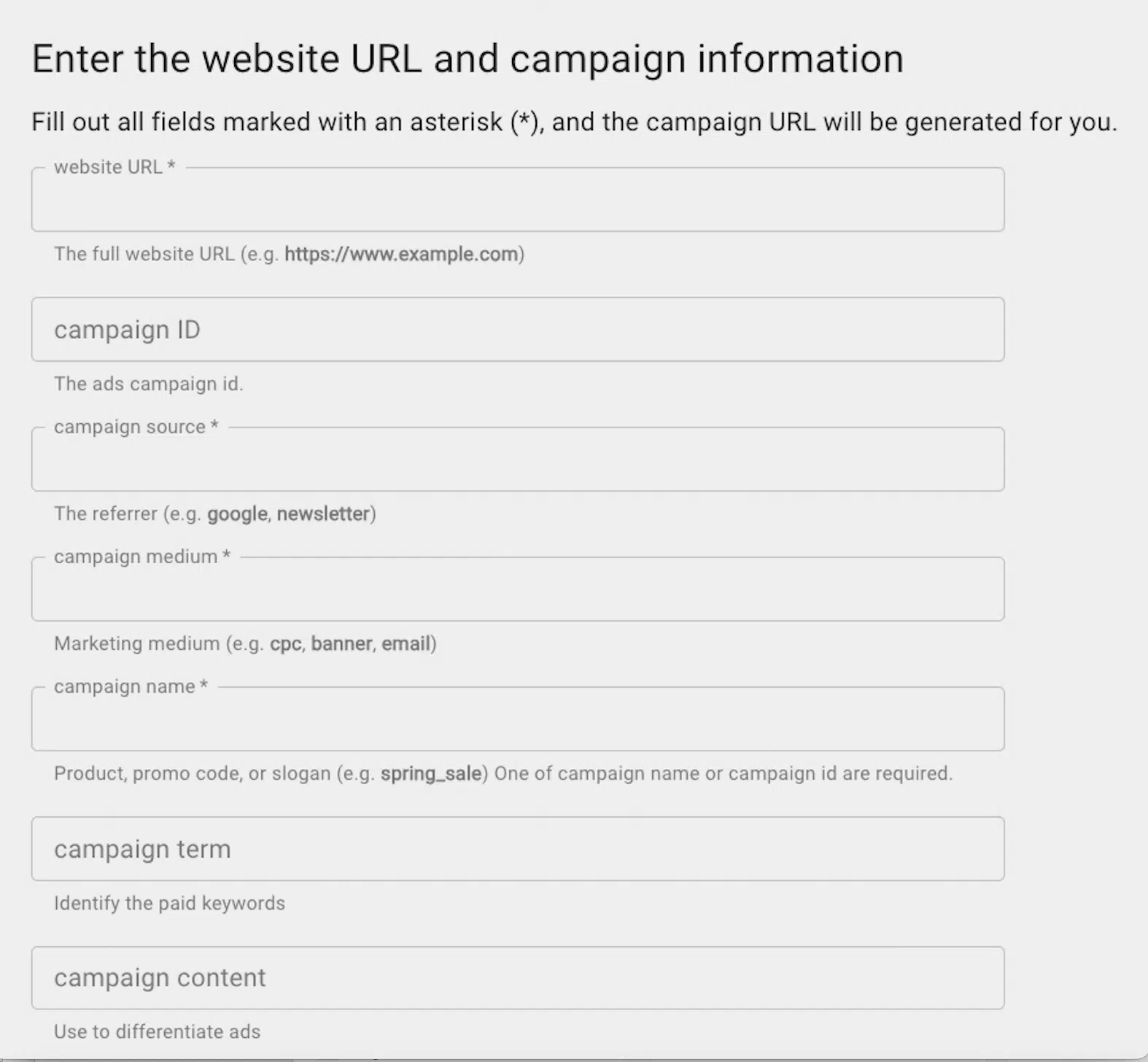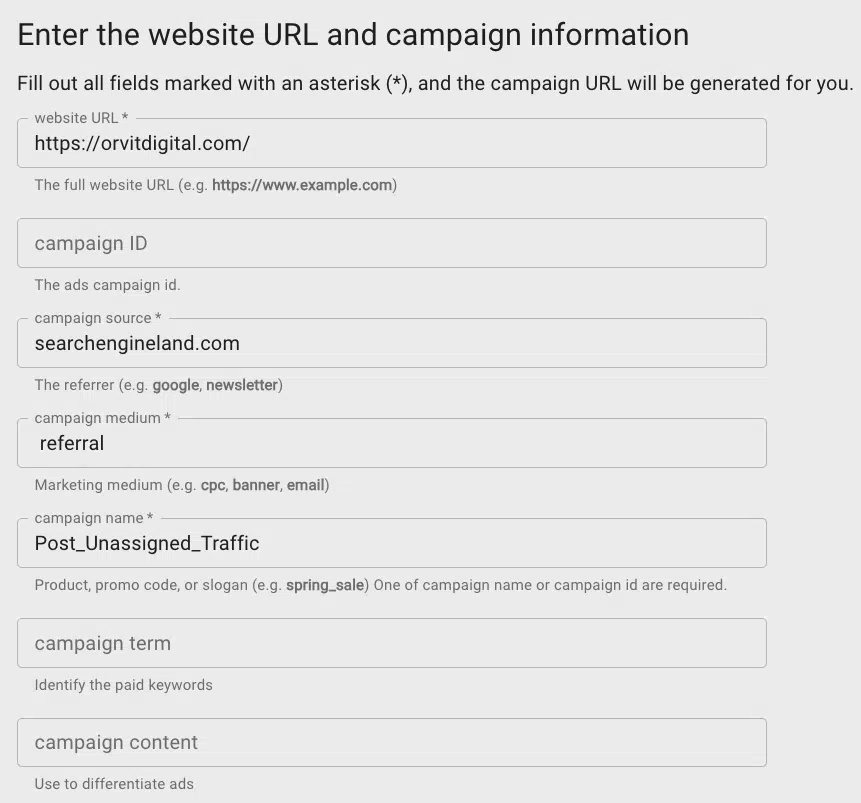How to fix unassigned traffic in GA4
Learn how to classify, track, and manage your web traffic effectively, ensuring your campaign traffic are never in the "Unassigned" category.
Unassigned traffic in Google Analytics 4 (GA4) is a common headache for digital marketers.
It’s like trying to solve a puzzle with missing pieces: your data is incomplete, making it hard to measure the success of your marketing efforts.
This article covers the common causes of unassigned traffic in GA4 and tips to ensure your campaigns are accurately tracked and optimized.
What is unassigned traffic?
Unassigned traffic refers to web traffic that isn’t categorized under any of the traffic sources or mediums provided by Google Analytics 4 (GA4).

Often, this arises when we use UTMs that reference traffic sources or mediums that GA4 doesn’t recognize. In such cases, Google labels this as Unassigned.
While this is a frequent reason, there can be other factors causing this classification.
How does GA4 classify user acquisition and traffic?
The traffic source dimensions provide information about where the website or app traffic comes from. GA4 provides different dimensions to analyze it. Among the most used include:
Default channel groups
- This dimension lets you delve into the channels that bring users to your site. Google offers a default list of channel groups.
- In 2024, GA4 updated its default channel groups, adding new categories such as email and SMS to better classify traffic and, among other objectives, reduce the amount of unassigned traffic.
Source
- Identifies the origin of your traffic, like from a search engine such as Google or another website.
Medium
- Indicates through which method you acquired the website traffic, i.e., via organic, CPC, etc.
First user source / medium
- Given at the user level, this indicates the source or medium responsible for the user’s initial session.
Session source / medium
- Assigned at the session level, this represents what originated the session.

What are the causes and how to prevent unassigned traffic in GA4?
Manual tagging based on source and medium
One of the main causes of unassigned traffic is the manual tagging of UTMs that do not follow Google’s recommendations.
UTM parameters enable you to manually tag URLs for emails, ads, and more. They can be easily added using Google’s Campaign URL Builder, providing insights into the origin of visits.

The essential and most recommended tagging fields are:
- Source and medium, which will allow you to identify where the campaigns come from.
- Campaign name, which allows you to assign a name to the campaign so you can analyze its results through the campaign dimension.
Below are common channels for manual traffic:

If you don’t tag these fields per Google’s recommendations, GA4 cannot group them into its predefined categories, and the traffic will be labeled as Unassigned.
For instance, if you want to manually tag a newsletter URL, you’ll have to fill in the UTM parameter fields using Google’s predefined ones:
https://www.tiodenadal.online/?utm_source=newsletter&utm_medium=email&utm_campaign=october_2023
*Newsletter is optional. If you choose to put this source, it is always recommended to stick with it. If not, we can set the name of the ESP used or look for how the source is tagged.

When tracking links from another website, verify your source and medium tracking, then create a UTM with a campaign ID:

https://orvitdigital.com/?utm_source=searchengineland.com&utm_medium=referral&utm_campaign=Post_Unassigned_Traffic

https://orvitdigital.com/?utm_source=searchengineland.com&utm_medium=referral&utm_campaign=Post_Unassigned_Traffic
For platforms like social networks or marketplaces, Google has a list of sources and categories to ensure accurate tagging and prevent unassigned traffic.
Common UTM tagging mistakes that cause unassigned traffic
Even if you manually tag your URLs, small mistakes can cause GA4 to misclassify the traffic.
Here are common errors to avoid when creating UTMs to classify your traffic manually:
- Tagging
utm_mediumas “newsletter” or “mail” instead of “email”- GA4 expects the predefined group “social”.
- Using capital letters inconsistently (like “Newsletter” vs. “newsletter”)
- GA4 treats them as different.
- Adding UTMs on internal links within your website
- For example, adding UTM parameters when linking from your homepage to a product or blog page can disrupt the original source/medium attribution, leading to traffic being marked as “unassigned.”
- Manually tagging Google Ads campaigns with UTMs instead of auto-tagging
- Google Ads handles source, medium, and campaign data automatically. If you add manual UTMs incorrectly, GA4 might ignore or classify them incorrectly.
- Incorrect UTM tagging in paid social campaigns
- For instance, using
utm_medium=paidinstead of utm_medium=paid_social– which GA4 expects for proper classification – can result in the traffic being miscategorized.
- For instance, using
AI traffic classification in GA4
As AI tools – especially chatbots – become increasingly important sources of website traffic, it’s essential to group this traffic into a dedicated channel within GA4.
Otherwise, it often ends up being classified as Referral or Unassigned, making it difficult to track and analyze effectively.
Currently, traffic from chats and other AI-driven tools is commonly lumped into these generic categories, alongside unrelated sources, which complicates accurate reporting.

Dig deeper: How to segment traffic from LLMs in GA4
How to properly classify AI traffic in GA4
Creating a dedicated AI traffic channel group in GA4 helps you better segment this growing source, reduce unassigned traffic, use it as a dimension in reports, and build more precise audiences.
- In your GA4 property, go to Admin > Data Display > Channel Groups.

- Copy the default channel group by clicking the three dots next to it and selecting Copy to create new.

- Name the new group something distinctive so it’s easy to identif – e.g., “Default Channel Group + AI.”

- Click Add new channel to create your AI traffic channel.
- Name it something intuitive like “AI Traffic” or just “AI”.
- Set the matching rule using a regex to capture common AI sources. Use the following regex:
^.*ai|.*\.openai.*|.*copilot.*|.*chatgpt.*|.*gemini.*|.*gpt.*|.*neeva.*|.*writesonic.*|.*nimble.*|.*outrider.*|.*perplexity.*|.*google.*bard.*|.*bard.*google.*|.*bard.*|.*edgeservices.*|.*gemini.*google.*$- Double-check that the regex captures all the AI traffic you want to track, and adjust it if necessary.

- Reorder the channels by moving the AI traffic channel above the general Referral or Unassigned channels. This ensures traffic from AI tools is categorized correctly before being grouped under broader categories.

- Save the new channel group.

- Go to Reports > Acquisition > Traffic Acquisition.
- Change the primary dimension in the table to the new AI traffic channel group.

- Check if you see “AI Traffic” in your reports. If your GA4 property has already received traffic from AI tools, it should appear.
- Use the search bar to filter by “AI Traffic” and isolate this type of traffic.
- Add a secondary dimension, like session source/medium, to gain deeper insights into where the AI traffic is coming from.

Other ways to prevent unassigned traffic
Since Universal Analytics ceased processing data in July 2023, GA4 has become Google’s primary analytics tool.
This means the tool may still have bugs, discoveries, and improvements. As of today, some other actions we can do to prevent unassigned traffic include:
Reporting identity
Google Analytics 4 uses methods like user ID, Google signals, device ID, and modeling for tracking user data across platforms. Selecting the right method can help prevent unassigned traffic.
Device-based is the recommended one nowadays.
Email traffic tracking
Incorrectly tagged email campaigns are one of the leading causes of unassigned traffic in GA4.
To avoid this, always ensure that all links inside your emails – including those in images – are properly tagged with UTM parameters:
- utm_source: This should be the platform or sender (e.g.,
newsletter,Mailchimp,HubSpot). - utm_medium: This should always be set as
email. - utm_campaign: Use this to specify the campaign name (e.g.,
winter_sale2025).
If your email marketing platform supports it, it’s also recommended to enable automatic UTM tagging to make sure every campaign is consistently tracked.
Cross-domain tracking
If your website uses multiple domains (for example, if users go from your blog domain to your shop domain), and you don’t set up cross-domain tracking, GA4 might lose the session information.
When this happens, it creates new sessions without a proper source or medium, and traffic can appear as Unassigned or Direct.
Here’s how to fix it:
- In GA4, go to Admin > Data Streams > Web > Configure tag settings.

- In the Settings section, click Configure your domain. Add all the domains where you want to maintain the same session.

- Save the changes.
To verify it works:
- Open a page with a link or form that points to another domain you’ve configured.
- Click the link or submit the form and check that the new page loads without errors.
- Verify that the URL in the destination domain contains the linker parameter
_gl. For example:https://www.example.com/?_gl=1*abcde5*
- If your website offers downloads, check that downloads start properly when the
_glparameter is present.
As Google points out, if you encounter an error, try troubleshooting cross-domain measurement.
Event configuration
Unassigned traffic can also stem from incorrectly configured events. Ensure your Google Tag Manager settings are spot-on.
Events and parameters must also be tagged following Google’s guidelines.
Other causes of unassigned traffic include:
- Events sent through regular tracking without session_start (h/t Antoine Eripre).
- Incorrect session tracking due to short user visits, ad blockers, or connection and data collection errors.
Ad blockers and other devices
Devices or ad blockers that hinder Google’s data capturing can also cause misclassifications of traffic, Himani Kankaria has found.
Simon Vreeman noted mobile apps as a potential source of channel assignment issues.
Use of audience triggers
As Himanshu Sharma highlighted the use of audience triggers in GA4 can greatly increase the volume of unassigned traffic.
If the event generated by the audience trigger isn’t tied to an existing session, perhaps because the session has ended or the criteria are met outside of the user’s current session, the source/medium might default to (not set) / (not set), which then appears as Unassigned in some GA4 reports.
Measurement Protocol events without client_id or session_id
As Julius Fedorovicius explains, when manually sending events to GA4 via the Measurement Protocol, it’s essential to include client_id, session_id, and, in some cases, timestamp_micros.
Without these, GA4 may be unable to associate the event with the correct session, resulting in traffic being marked as unassigned.
The Measurement Protocol is designed to add events to existing sessions, not to create new ones.
To avoid data gaps, always ensure your server-side events include the necessary parameters.
Managing unassigned traffic in GA4
Addressing unassigned traffic in GA4 requires a combination of best practices, accurate tracking, and awareness of potential causes.
Implement these tips to ensure your campaigns are accurately tracked and optimized, providing a more comprehensive view of your marketing performance.
Contributing authors are invited to create content for Search Engine Land and are chosen for their expertise and contribution to the search community. Our contributors work under the oversight of the editorial staff and contributions are checked for quality and relevance to our readers. Search Engine Land is owned by Semrush. Contributor was not asked to make any direct or indirect mentions of Semrush. The opinions they express are their own.


